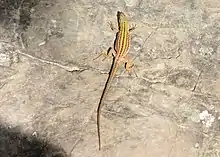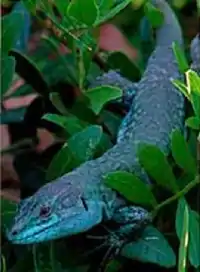Italian wall lizard
The Italian wall lizard or ruin lizard (Podarcis siculus from the Greek meaning 'agile' and 'feet') is a species of lizard in the family Lacertidae. P. siculus is native to Bosnia and Herzegovina, Croatia, France, Italy, Serbia and Montenegro, Slovenia and Switzerland, but has also been introduced to Spain, Turkey, the United States and Canada.[1] P. siculus is the most abundant lizard species in southern Italy.[2]
| Italian wall lizard | |
|---|---|
 | |
 | |
| Scientific classification | |
| Kingdom: | Animalia |
| Phylum: | Chordata |
| Class: | Reptilia |
| Order: | Squamata |
| Family: | Lacertidae |
| Genus: | Podarcis |
| Species: | P. siculus |
| Binomial name | |
| Podarcis siculus (Rafinesque, 1810) | |
| Synonyms | |
| |
P. siculus gained attention in 2008 following the publication of a research study[3] that detailed distinct morphological and behavioral changes in a P. sicula population indicative of "rapid evolution".[4][5][6]
Habitat
Its natural habitats are Mediterranean-type shrubby vegetation, rocky areas, rocky shores, sandy shores, rural gardens, pastureland, plantations and urban areas.
Subspecies

P. siculus contains dozens of subspecies.[7] The current distribution patterns of the subspecies have been interpreted as the consequence of natural events, including regional glacial refuges and postglacial area expansions, and multiple introductions by man.[8]
The island endemic Santo Stefano lizard (P. s. sanctistephani) became extinct in 1965 after introduction of predators, interbreeding with introduced wall lizards, and a disease epidemic which wiped out the last remnants.
List of subspecies: Podarcis siculus adriaticus, Podarcis siculus aemiliani, Podarcis siculus amparoae, Podarcis siculus astorgae, Podarcis siculus bagnolensis, Podarcis siculus bolei, Podarcis siculus calabresiae, Podarcis siculus campestris, Podarcis siculus caporiaccoi, Podarcis siculcus attaroi, Podarcis siculus cettii, Podarcis siculus ciclopica, Podarcis siculus coeruleus, Podarcis siculus cucchiarai, Podarcis siculus dupinici, Podarcis siculus fiumanoideus, Podarcis siculus flavigulus, Podarcis siculus gallensis, Podarcis siculus hadzii, Podarcis siculus hieroglyphicus, Podarcis siculus insularus, Podarcis siculus klemmeri, Podarcis siculus kolombatovici, Podarcis siculus laganjensis, Podarcis siculus lanzai, Podarcis siculus latastei, Podarcis siculus massinei, Podarcis siculus monaconensis, Podarcis siculus nikolici, Podarcis siculus palmarolae, Podarcis siculus pasquinii, Podarcis siculus paulae, Podarcis siculus pelagosae, Podarcis siculus pirosoensis, Podarcis siculus pohlibensis, Podarcis siculus premudanus, Podarcis siculus premudensis, Podarcis siculus pretneri, Podarcis siculus radovanovici, Podarcis siculus ragusae, Podarcis siculus salfii, Podarcis siculus samogradi, Podarcis siculus sanctinicolai, †Podarcis siculus sanctistephani, Podarcis siculus siculus, Podarcis siculus tyrrhenicus, Podarcis siculus vesseljuchi. [9]
Rapid adaptation
.jpg.webp)
In 1971, ten adult specimens (five breeding pairs) of Podarcis siculus were transported from the Croatian island of Pod Kopište to the island Pod Mrčaru (about 3.5 km to the east). Both islands lie in the Adriatic Sea near Lastovo), where the lizards founded a new bottlenecked population.[3][10] The two islands have similar size, elevation, microclimate, and a general absence of terrestrial predators[10] and the P. siculus expanded for decades without human interference, even out-competing the (now locally extinct)[3] Podarcis melisellensis population.[11]
In the 1990s, scientists returned to Pod Mrčaru and found that the lizards currently occupying Mrčaru differ greatly from those on Kopište. While mitochondrial DNA analyses have verified that P. siculus currently on Mrčaru are genetically very similar to the Kopište source population,[3] the new Mrčaru population of P. siculus was described as having a larger average size, shorter hind limbs, lower maximal sprint speed and altered response to simulated predatory attacks compared to the original Kopište population.[10] These population changes in morphology and behavior were attributed to "relaxed predation intensity" and greater protection from vegetation on Mrčaru.[10]
In 2008, further analysis revealed that the Mrčaru population of P. siculus have significantly different head morphology (longer, wider, and taller heads) and increased bite force compared to the original Kopište population.[3] This change in head shape corresponded with a shift in diet: Kopište P. siculus are primarily insectivorous, but those on Mrčaru eat substantially more plant matter.[3] The changes in foraging style may have contributed to a greater population density and decreased territorial behavior of the Mrčaru population.[3]
Another difference found between the two populations was the discovery, in the Mrčaru lizards, of cecal valves, which slow down food passage and provide fermenting chambers, allowing commensal microorganisms to convert cellulose to nutrients digestible by the lizards.[3] Additionally, the researchers discovered that nematodes were common in the guts of Mrčaru lizards, but absent from Kopište P. siculus, which do not have cecal valves.[3] The cecal valves, which occur in less than 1 percent of all known species of scaled reptiles,[3] have been described as an "adaptive novelty, a brand new feature not present in the ancestral population and newly evolved in these lizards".[12]
As an introduced species
Populations of P. siculus in North America have been documented from Topeka, Kansas, Long Island, New York, Greenwich, Connecticut and Levittown, Pennsylvania.[13][14] The species seems to be extending its range from an initial colonization event in western Long Island, presumably by using railroad tracks as dispersal corridors.[15] On the west coast, ''P. sicula'' was introduced to San Pedro, California in 1994 by a traveler coming back from the island of Sicily.
See also
References
- Crnobrnja-Isailovic, J.; Vogrin, M.; Corti, C.; Pérez Mellado, V.; Sá-Sousa, P.; Cheylan, M.; Pleguezuelos, J.; Sindaco, R.; Romano, A. & Avci, A. (2009). "Podarcis siculus". IUCN Red List of Threatened Species. 2009: e.T61553A86151752. doi:10.2305/IUCN.UK.2009.RLTS.T61553A12515189.en.{{cite iucn}}: error: |doi= / |page= mismatch (help)
- De Falco M, Sciarrillo R, Virgilio F, et al. (August 2004). "Annual variations of adrenal gland hormones in the lizard Podarcis sicula". J. Comp. Physiol. A. 190 (8): 675–81. doi:10.1007/s00359-004-0528-1. PMID 15170520. S2CID 10821629.
- Herrel A, Huyghe K, Vanhooydonck B, et al. (March 2008). "Rapid large-scale evolutionary divergence in morphology and performance associated with exploitation of a different dietary resource". Proc. Natl. Acad. Sci. U.S.A. 105 (12): 4792–5. Bibcode:2008PNAS..105.4792H. doi:10.1073/pnas.0711998105. PMC 2290806. PMID 18344323.
- "National Geographic: Lizards Rapidly Evolve After Introduction to Island". 2008-04-21. Retrieved 2008-05-27.
- "Science Daily: Lizards Undergo Rapid Evolution After Introduction To A New Home". Retrieved 2008-05-27.
- "Newswise: Lizards Undergo Rapid Evolution After Introduction to New Island". Archived from the original on 2011-08-20. Retrieved 2008-08-06.
- "TYPICAL LIZARDS (Lacertidae): Podarcis sicula ssp". Archived from the original on 2008-06-11. Retrieved 2008-06-02.
- Podnar M, Mayer W, Tvrtković N (February 2005). "Phylogeography of the Italian wall lizard, Podarcis sicula, as revealed by mitochondrial DNA sequences". Mol. Ecol. 14 (2): 575–88. doi:10.1111/j.1365-294X.2005.02427.x. PMID 15660947. S2CID 2955146.
- "Podarcis siculus".
- Bart Vervust; Irena Grbac; Raoul Van Damme (August 2007). "Differences in morphology, performance and behaviour between recently diverged populations of Podarcis sicula mirror differences in predation pressure". Oikos. 116 (8): 1343–1352. doi:10.1111/j.0030-1299.2007.15989.x.
- "Lizards Rapidly Evolve After Introduction to Island". National Geographic. 2008-04-21.
- Myers, PZ (23 April 2008). "Still just a lizard". ScienceBlogs.
- "This little lizard made our front yard his home".
- https://www.researchgate.net/publication/269631367_Italian_Wall_Lizard_%28Podarcis_sicula%29_The_first_population_found_in_New_England
- "Archived copy" (PDF). Archived from the original (PDF) on 2015-09-24. Retrieved 2015-01-29.CS1 maint: archived copy as title (link)
External links
 Media related to Podarcis sicula at Wikimedia Commons
Media related to Podarcis sicula at Wikimedia Commons
